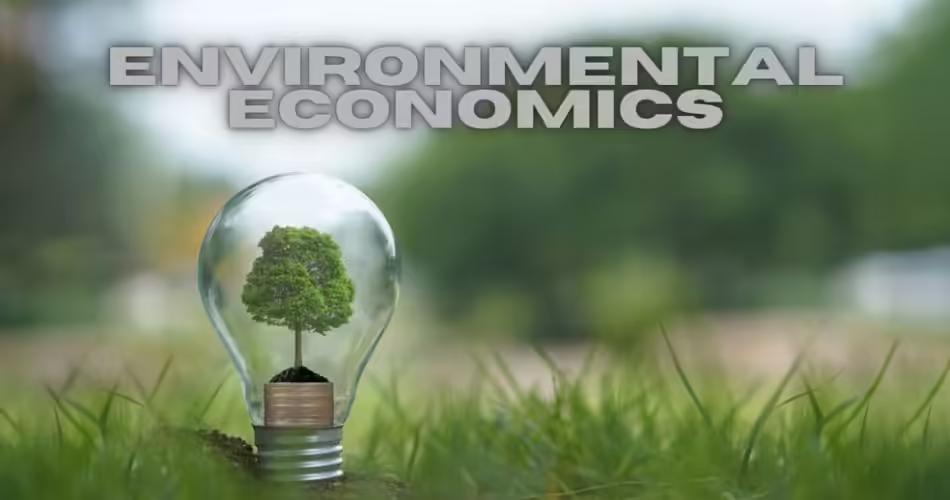This blog will help you learn about Environmental Economics. In the start it will discuss what is Economics and Environmental Economics. We will know about Key Concepts, Father of Environmental Economics, Principles of Environmental Economics, Environmental Economics and Environmental Ecology, Examples, branches and Management of Environmental Economics.
Introduction to Environmental Economics:
It is the study of cost effective and efficient allocation, use, and so the protection of the world’s natural resources.
Economics is the study that guides us about how people produce and consume goods and services. While in case of environmental economics, we study about how to use and manage natural resources for the population in an efficient way. Environmental economics helps us to become cost-effective against the environmental issues, to make the environment healthy and clean in an efficient manner so this blog contains Principles, Branches and comparison of Env. Economics with Environmental Ecology.
Key Concepts of Environmental Economics:
Following are the key concepts of Environmental Economics:
i. Market Failure and Externalities
One of the main concept of Environmental economics is the fact that, so markets often fails to reflect the original cost of the environmental damage. In case, a factory emits pollutants into the environment without dealing with the health impacts on surrounding communities. These marks as Negative externalities. The solution to this worldwide issue is Carbon pricing and Pollution taxes. These can help us to fight these environmental issues. This counts in the department of Env. economics.
ii. Green Growth and Sustainable Development
Green growth recognizes the concept of economic growth that promises to never harm the environment. Many huge firms and companies are investing in Sustainable Development to reduce the environmental damage using this concept as their foundation. Other initiatives includes Waste reduction, renewable energy and also clean energy utilization. This protects the ecosystem as well as create new options for people like Green Jobs, innovations and Eco-friendly Technologies.
iii. Valuing Natural Capital and Ecosystem Services
The Environmental Economists use latest tools and technologies to evaluate the monetary value to non-market goods i.e. clean rivers, biodiversity or scenic landscapes. These tools includes contingent valuation and hedonic pricing etc. These evaluations and valuations helps business and governments to highlight the benefits of conserving natural resources and natural landscapes in order to justify Green Investments in Green Economy Projects in the region.
These are the major key concepts in Environmental Economics. This blog contains examples and Management in Environmental Economics.
Who is the Father of Environmental Economics?
The father of Environmental Economics is Herman Daly. He was an economics student. At the point when he began to study economics during the 1950s at Rice College, in his old neighborhood of Houston, he was a “growther” — very much like basically every other financial specialist. The principles were basic: You continue to deliver more things for individuals to utilize, and also the market framework decently disseminates these things; abundance streams down and everybody’s life step by step improves. Furthermore, this was incredible information to Daly on the grounds that improving the world was what he profoundly needed to do.
Basic Principles of Environmental Economics:
Basic economic concepts specifically relevant to environmental economics
- The economics of natural resource scarcity
- Ecology, economics and also the biophysical constraints to economic growth
- Ecological economics
- The economics of sustainable development
- The economics of pollution
- Valuing the environment
- The economics of natural resources
- Population, development and the environment
All these areas are concerned with environmental economics directly or indirectly. It is a very important field in the present situation because it provide us strategies to overcome the deficiency of resources for the present day population. It also considers the environmental issues causing destruction in the environment and depletion of natural resources, then offer suitable strategies to apply.

Environmental Economics vs Environmental Ecology:
Env. Economics:
- It helps us to be cost-effective against environmental issues.
- These is not compulsion of maintaining natural stock as long as the externalities are eliminated.
- It studies the relationship of environment and the economy.
- Example: Corporate Average Fuel Economy etc.
Env. Ecology:
- It considers the economy to be the subsystem of wider ecosystem.
- It works in maintaining the total natural stock at, or above current level.
- It studies the relationship between environment and ecology.
- Example: Energy movement from food webs among different species etc.
Branches of Environmental Economics:
Following are the Two main branches of Environmental Economics:
Natural Capitalism:
Natural Capitalism is an evaluation of conventional “Modern Free enterprise”, saying that the customary arrangement of free enterprise “doesn’t completely adjust to its own bookkeeping standards. It sells its capital and calls it pay. It fails to appoint any worth to the biggest supplies of capital it utilizes – the normal assets and living frameworks, as well as the social and social frameworks that are the premise of human resources.”
Natural Capitalism perceives the basic interdependency between the creation and utilization of human-made capital and the upkeep and also supply of normal capital. The creators contend that main through perceiving this fundamental relationship with the World’s important assets can organizations, and individuals they support, keep on existing.
Environmental Finance:
Environmental Finance is a field inside finance that utilizes market-based ecological strategy instruments to work on the biological effect of speculation strategies so the essential target of environmental finance is to relapse the adverse consequences of environmental change through estimating and exchanging schemes. The field of environmental finance was laid out because of the unfortunate administration of monetary emergencies by government bodies globally. Environmental Finance means to redistribute an organizations assets to work on the manageability of ventures while likewise holding benefit margins.
These are the main branches of Environmental Economics.
Environmental Economists:
The professionals of environmental economics are called as environmental economists. The job of environmental economist is that he conducts economic analysis related to environmental-protection and use of natural environment, such as water, air, land, and renewable energy resources. He also evaluates and quantify benefits, costs, incentives, and impacts of alternative options using economic principles and statistical techniques. This provide us prediction about the losses and profits of applying the environmental strategies by providing quantitative information.
They also provides suitable strategies to help large organization or government to work on any project in environmental friendly processes and cost-effective use of resources to avoid any damage to environment. This ensures efficient and cost-effective way to conserve and so use resources. This blog discusses Principles and Branches of Environmental Economics.
Examples of Environmental Economics:
The examples of the use of environmental economics are as follows:
Cap and Trade system:
Cap and trade system is a prominent example of Environmental Economics. Companies purchase carbon offsets from developing countries or environmental organizations to make up for their carbon emissions.
Carbon Tax:
Another example is the use of a carbon tax to penalize industries that emit carbon. These industries and firms are forced to pay a specified tax to the government according to their carbon emissions.
Corporate average fuel economy (CAFE):
Corporate average fuel economy (CAFE) regulations are another example of environmental economics at work. These regulations are prescriptive and specify the gallons per mile of gas for cars for car makers. They were introduced during the 1970s to promote fuel efficiency in an era of gas shortages.
Recycling Technologies:
Many recycling technologies are established by taking help from Environmental economics that help a lot in increasing the resource efficiency and in implementing 4R Strategy in the system.
These are some of the Examples of Environmental Economics. This blog discusses Principles and Branches of Environmental Economics.
Environmental Management System:
EMS or Environmental Management system is a structural approach that guides the organizations to reduce their environmental footprint. It follows the standards like ISO 14001. This system involves planning, monitoring and improving environmental performance.
EMS in Businesses
In the field of Business, EMS is utilized to improve Cost savings, better resource allocations, energy efficiency and so as the waste reduction. These collectively reduce Environmental Footprint.
EMS for Governments
EMS helps governments in establishing Sustainable policies that correlates the environmental principles efficiently. This really helps in managing the environment on national level.
Environmental Management system is the best tool for the firms and leaders to protect the environment from excessive damage. Its implementation can be so helpful in conserving natural environment.
Environmental Economics and Management:
The Environmental Economics and Management (EEM) program prepares you for a career that requires balancing environmental sustainability and also economic development goals. The major is a broad, integrated study of environmental economics, public finance, economic development, community and regional studies and environmental science. It is a new field that will be very important in the future because management of environmental resources has to be applied in every field.
Importance of Environmental Economics:
Environmental Economic aspects concentrates on the effect of ecological approaches and devises answers for issues coming about because of them. Environmental Economic aspects can either be prescriptive-based or motivation based. A significant subject of natural financial matters is externalities, the extra expenses of carrying on with work that are not paid by the business or its shoppers. One more significant subject of Environmental Economics matters is putting a worth on open products, like clean air, and working out the expenses of losing those merchandise. Since a few natural products are not restricted to a solitary country, ecological financial matters frequently requires a transnational methodology.
Policy Pathways and Future of Environmental Economics:
- More investments in Renewable Energy projects
- Carbon Taxes to reduce the emissions
- Facilitating research in eco-friendly technologies and also Climate Change Mitigation
- Encouraging the businesses to adopt sustainable supply chains and Green Investment strategies. etc.
Conclusion:
Environmental Economics is the field of Environmental sciences that deals with the cost-effective and efficient use and management of natural resources that are consumed by the population. It helps us to provide statistical analysis and quantification of the benefits and losses of any environmental strategy before time. And then provide suitable strategies to overcome resource loss and excessive money. We are facing a lot of environmental issues in present time, that is why is field is very important to make environmental conditions better for humans. This blog discusses Principles and Branches of Environmental Economics.

To learn about more topics, Click the links below:


Comments